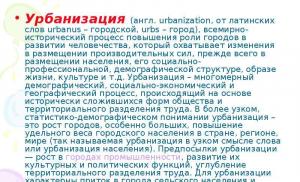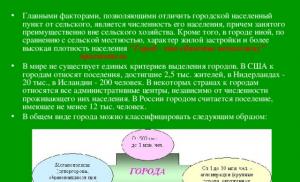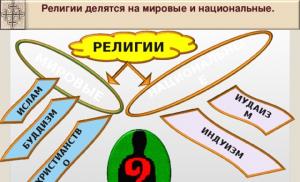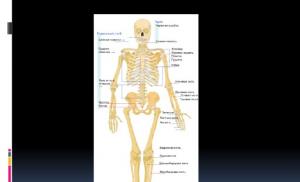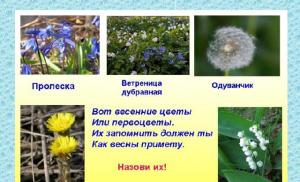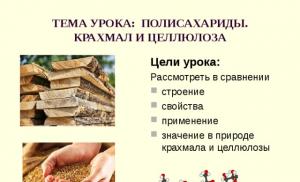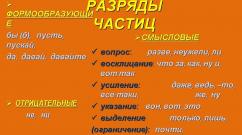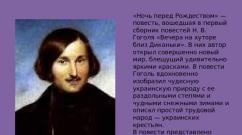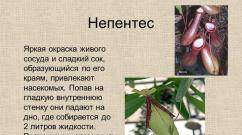Presentation on the topic "human skeleton". Human skeleton, its structure and meaning
Slide 2
Slide 3
Skeletal functions
The human skeleton consists of bones (there are more than 200 of them) and their joints. In addition to the main functions (support, protection, movement), the bones of the skeleton participate in mineral metabolism and also contain red bone marrow, a hematopoietic organ.
Slide 4
Connection of bones
The connection of bones in the skeleton is divided into three types: fixed, semi-mobile and mobile. The fixed connection is represented by the bones of the skull.
Slide 5
Semi-movable connection of bones - the connection of the vertebrae or ribs with the sternum, carried out with the help of cartilage and ligaments.
Slide 6
Types of joints
Finally, the joints are movably connected. Each joint consists of articular surfaces, a bursa and fluid located in the articular cavity. Joint fluid reduces bone friction during movement. Joints are most often strengthened by ligaments, which limit the range of motion.
Slide 7
Joint structure
Slide 8
Slide 9
Fill out the table
Slide 10
Head skeleton (skull)
The skeleton of the head (skull) has a cavity in which the brain is located. In addition, there are cavities of the mouth, nose and receptacles for the organs of vision and hearing. Usually the brain and facial parts of the skull are distinguished. In humans, the brain region predominates. All bones of the skull, with the exception of the lower jaw, are connected by sutures.
Slide 11
The brain section of the skull consists of two paired bones - the temporal and parietal and four unpaired bones - the frontal, ethmoid, sphenoid and occipital. The facial section is represented by six paired bones - the upper jaw, nasal, lacrimal, zygomatic, palatine and inferior nasal concha and two unpaired bones - the lower jaw and vomer. The bones of the face also include the hyoid bone.
Development of the shape of the lower jaw with age1 - jaw of a newborn2 - jaw of a four-year-old child3 - jaw of a 6-year-old child4 - jaw of an adult5 - jaw of an old man (teeth have fallen out)
Slide 12
The structure of the skull bones
Slide 13
Spine
The spine consists of 33-34 vertebrae and five sections: cervical - 7 vertebrae, thoracic - 12, lumbar - 5, sacral - 5 and coccygeal - 4-5 vertebrae.
Slide 14
The spinal column of a newborn is almost straight, and with further development, curves of the spine are formed. The spine has two forward bends - lordosis (cervical and lumbar) and two backward bends - kyphosis (thoracic and sacral).
Slide 15
The main purpose of the bends is to reduce the shaking of the head and torso when walking, running, and jumping.
Slide 16
There is a curvature of the spine to the side - scoliosis. Scoliosis is often the result of painful changes in the spine.
Slide 17
Slide 18
The vertebra consists of a body and an arch, from which 7 processes extend: spinous, 2 transverse and 4 articular. The vertebral body faces forward, and the spinous process faces backward; in the middle there is a vertebral foramen; the openings of all the vertebrae form a canal in which the spinal cord is located.
Slide 19
The vertebrae are connected to each other through cartilage, joints and ligaments. The spine is capable of bending and unbending, bending to the side and twisting. The most mobile areas are the lumbar and cervical spine.
Slide 20
Rib cage
The chest is formed by the thoracic vertebrae, twelve pairs of ribs and the chest bone - the sternum.
Slide 21
The sternum is a flat bone, in which three parts are distinguished: the upper one is the manubrium, the middle one is the body and the lower one is the xiphoid process.
Slide 22
Development of the chest
1 - cartilaginous thorax of a 4-week fetus. 2 - thorax of a 5-week fetus. 3 - thorax of a 6-week fetus. 4 - thorax of a newborn.
Slide 23
Skeleton of the upper limb belt
The skeleton of the upper limbs consists of the shoulder girdle and the skeleton of the free upper limbs. The shoulder girdle consists of a pair of clavicles and shoulder blades.
Slide 24
Upper limbs
The upper limb (arm) is composed of the humerus, forearm bones and hand bones (bones of the wrist, metacarpus and phalanges of the fingers).
Slide 25
Hand bones
The joints of the hand differ significantly in the variety of movements and mobility, which is associated with the transformation of the forelimb into a labor organ in the process of evolution.
summary of presentationsSkeleton
Slides: 10 Words: 373 Sounds: 0 Effects: 44Excretory system. Digestive system. Bony plates covering the respiratory organs of fish. Protection from damage. Skeletal functions. What types of skeleton do you know? Snail. Cat. Bee. Frog. Cancer. Turtle. Mallard. Earthworm. Sea bass. Sea urchin. Leech. Human. Skeleton. Hydroskeleton. Plant skeleton. Stem. Root. Sheet. Something like a cylinder. Frame, shape. - Skeleton.ppt
Human skeleton
Slides: 17 Words: 351 Sounds: 0 Effects: 30Human skeleton. Biological dictation. Inorganic compounds give bones __a)___. Organic compounds give bones __b)___. Unlike the exoskeleton, the internal skeleton grows with the body. Skull brain section. Facial section: upper and lower jaws, zygomatic, nasal, ethmoid bones. Human skull. Independent work. Look at the drawing on page 52 of the textbook and complete the task in workbook No. 35 on page 18. Skeleton of the torso. The structure of the vertebrae. Skeleton of the shoulder girdle and upper limbs. Bones of the lower limbs and legs with part of the spine. - Human skeleton.ppt
Biology "Skeleton"
Slides: 19 Words: 860 Sounds: 0 Effects: 23The lever system of the human skeleton. The human skeleton is a collection of bones. General diagram of the skeleton. The number of bones in the human skeleton. Individual parts of the skeleton can be distinguished already in a 5-week-old embryo. Movement plays a huge role in the life of all living beings. Basic functions of the skeleton. Biology "Skeleton". Movable joints are called joints. Support points. Our muscles work almost constantly, even when we are just standing. Sketchy biceps - strength. Biology "Skeleton". The musculoskeletal system is a system of three types of levers. Levers of the first kind. Biology "Skeleton". The hand is the “speed lever”. - Biology "Skeleton".pptx
The skeleton is the support of the body
Slides: 6 Words: 74 Sounds: 0 Effects: 1Topic: The skeleton is the support of the body. Check of knowledge. What advantages does having a skeleton give animals? SKELETON External internal. Protozoan skeleton. Skeleton of mollusks. - The skeleton is the support of the body.ppt
Biology "Human Skeleton"
Slides: 22 Words: 698 Sounds: 0 Effects: 107Presentation for a biology lesson, grade 8. Human skeleton. From the list of substances (1-10), select the correct answers to questions (A-M). Organic substances give bones elasticity, minerals give hardness. Passive part. Skeleton (skeletos - dried) is a collection of hard tissues. Functions of the skeleton. Sections of the skeleton. Scull. Frontal bone. Body parts. The human skeleton has a number of differences from the skeleton of mammals. Skeletal bones. Spine. The spine has 4 curves. Rib cage. The chest is expanded downwards and to the sides. Consolidation of what has been learned. Homework. Bone (os, ossis) is an organ, the main element of the vertebrate skeleton. - Biology “Human Skeleton”.ppt
Skeletal structure
Slides: 13 Words: 172 Sounds: 0 Effects: 13Topic: “Musculoskeletal system.” Lesson 2. Axial skeleton and limb skeleton. List of slides: Structure of the skull. Structure of the skull (bottom view). The structure of the vertebrae. Vertebral structure. Sections of the spine. Sections of the spine (continued). Rib cage. Shoulder girdle and arm skeleton. Skeleton of the hand. Pelvic girdle. Leg skeleton. Completed by biology teacher of gymnasium 22 Ketukh Aida Genrikhovna. Structure of the skull. A - lumbar. B - cervical. B - chest. 1 – posterior process. 2 – vertebral body. 3 - arc. 4 – lateral processes. 1 – cervical 2 – thoracic 3 – lumbar 4 – sacral 5 – coccygeal. - Skeletal structure.ppt
Structure of the human skeleton
Slides: 18 Words: 881 Sounds: 0 Effects: 26Human skeleton. Skeletal structure. Shape of bones. Bones differ from each other in shape and structure. There are tubular, flat, mixed and air-bearing bones. Mixed bones include vertebrae and bones of the base of the skull. Axial skeleton. The spine is the most ancient part of the human skeleton. During development, some bones fuse together. Vertebral structure. Each vertebra consists of a body and an arch, between which there is an opening. Joint. The joint is usually strengthened by ligaments. Articular fluid is produced by cells lining the inner surface of the joint capsule. - Structure of the human skeleton.ppt
Features of the skeleton structure
Slides: 19 Words: 811 Sounds: 0 Effects: 2Development. Pedagogical credo. Skeleton. Relevance of knowledge. Warm up. Skeleton and muscles. Scull. Types of bone connections. Types of joints. Developmental defects. National component. Flat feet. First aid for skeletal injuries. Dislocations and fractures. Conclusions and recommendations. Natural science. About Me. Features of the structure of the skeleton. Thank you for your attention. - Features of the structure of the skeleton.ppt
Bones
Slides: 26 Words: 614 Sounds: 0 Effects: 0Human skeleton. Functions of the skeleton. Connection of bones. Fixed connection of bones. Semi-movable joint of bones. Movable connection of bones. Divisions of the human skeleton. Skeleton of the head. Bones. Skeleton of the body. Spine. Curves of the spine. Rachiocampsis. Vertebrae. Rib cage. Skeleton of the upper limbs. Shoulder girdle. Upper limbs. Bones of the hand. Skeleton of the lower extremities. Pelvic girdle. Lower limbs. Femur. Bones of the foot. Features of the human skeleton. Brain section of the skull. - Bones.pptx
Bone structure
Slides: 25 Words: 449 Sounds: 0 Effects: 52Movement is life. Chemical composition. Structure. Distribute into groups. Answer. Biology. Properties. Complex structure. Strength. Bone strength. Hardness. Fragility. Chemical composition of bone. Bone structure. Spongy substance. Bone structure. Basic concepts. O. Organic matter. Experience. The properties of bone are determined by the physicochemical unity of its composition. Bone structure. Bone structure. Bone structure. Bone structure. - Bone structure.ppt
Structure and properties of bones
Slides: 19 Words: 1049 Sounds: 0 Effects: 56The importance of the musculoskeletal system. Functions of the musculoskeletal system. Functions of the musculoskeletal system. Bone. Type and properties of bones. Organic substances. Chemical composition of bones. Changes in the content of organic and inorganic substances. Experience. Types of bones. Microscopic structure of bone. Compact substance of bone tissue. Find the tubules. Macroscopic structure of bone. Bone growth. Properties of bone. Types of bone connections. Run the test. Homework. - Structure and properties of bones.ppt
Bone fractures
Slides: 11 Words: 470 Sounds: 0 Effects: 0Why are older people more likely to break bones when they fall? Target. Find out why bones become more fragile in older people. Find out what substances make up bones. Find out what properties inorganic substances give to bones. Find out what properties organic substances give to bones. Do changes in bone composition occur with age? From the literature we learned that bones contain: Organic matter – 60%. Experience 1! Then we wash the bone. This decalcified bone can be tied in a knot. This means that organic substances give bones flexibility and elasticity. - Bone fractures.ppt
Head skeleton
Slides: 27 Words: 620 Sounds: 0 Effects: 85Skeleton of the head. The skull consists of two parts. Brain section of the skull. Functions of the brain. Functions of the facial region. Handkerchief. Brain department. Parietal bone. Ethmoid bone. Sphenoid bone. Base of skull. Temporal bone. Which bone of the skull is movable? Processes of the zygomatic and temporal bones. Posterior openings of the nasal cavity. Facial section. Nasal bones. Nasal septum. Bone walls of the orbit. Paranasal sinuses. Connections of the bones of the skull. Development of the skull. The ratio of the volume of the facial skull to the brain in a newborn. The bones of the newborn's skull are separated. Roof of the skull. - Head skeleton.ppt
Scull
Slides: 11 Words: 168 Sounds: 0 Effects: 20Scull. Stages of development. During its formation, the skull goes through three stages - connective tissue, cartilage and bone. Functions of the skull. Structure. The skull consists of two sections: the visceral (facial) and the brain (cranial box). Moreover, in humans, unlike animals, the cerebral skull significantly predominates over the facial skull. All bones of the skull, except the lower jaw, are connected by a fixed joint. Human skull. The difference between the human skull and that of apes lies primarily in the fact that the human skull in its shape is adapted to straight walking. The head balances on the spine, which causes the neck muscles to be less strong and the skull itself to be thinner. -
Structure of the skull
Slides: 19 Words: 1262 Sounds: 0 Effects: 85Students. Anatomy. Scull. The skull consists of two sections. Structure of the skull. Occipital bone. Bones of the facial skull. Structure of the skull. Age-related features of the skull. Periods of skull transformation. Frontal section. Period of skull transformation. Skull buttresses. Types of buttress. Wing-palatal buttress. Inner base of the skull. A pot on the shoulders. Temporal bones. Bibliography. -
Human axial skeleton
Slides: 34 Words: 1560 Sounds: 0 Effects: 118Axial skeleton and limb skeleton. Conditions for students to actively familiarize themselves and consolidate the structure of the skeletal departments. Review parts of the musculoskeletal system. Independent work skills. Lesson plan. Checking homework. Chemical composition of bones. Bone sizes. What types of bones do you know? Human skeleton. Skeleton. Learning new material. Comparison of the human and mammalian skeletons. Comparison of human and gorilla skeletons. Conclusions comparing human and mammalian skeletons. The number of bones in the human body. This is interesting. Axial skeleton. Sections of the skeleton. The structure of the human skeleton. - Human axial skeleton.pptx
Skeleton of limb belts
Slides: 24 Words: 660 Sounds: 0 Effects: 155Skeleton of limb girdles. Bone connections. What is the significance of the skeleton? Sections of the skeleton. Skeleton. Upper limb. Human skeleton. Skeleton of the lower extremities. Lower limb. Wide pelvis. Massive bones of the lower limb. Joints. Types of bone connections. Seams. The structure of the joint. Body parts. Sections of the skeleton. Features of the structure of the human skeleton. Homework. Functions of the skeleton. Back. Scull. 1. Chest. - Skeleton of limb belts.ppt
Physical activity
Slides: 8 Words: 218 Sounds: 0 Effects: 0Correct human motor activity. In childhood. Research by hygienists. A change in the amount of physical activity was noted in different academic quarters. Exercise. Motor mode. In addition to exercise, physical education includes outdoor games. Team games are well disciplined: volleyball, basketball, football. Motor mode of the child. A walk in the evening before bedtime is especially important for a child. Punishing a child by depriving him of a walk is unacceptable! - Motor activity.ppt
Musculoskeletal system
Slides: 7 Words: 219 Sounds: 0 Effects: 5Performance. The presentation of the topic consists of seven lessons and an event summarizing the topic. Written planning and slides are provided for each lesson and activity. Materials are presented in printed and electronic form. The presentation of the topic was carried out by the author independently. Topic: “Musculoskeletal system.” List of lessons: Musculoskeletal system: composition and functions. Axial skeleton and limb skeleton. Connection of bones. First aid for skeletal injuries. Muscles: structure and functions. Muscle work. Movement regulation. The importance of physical exercise. Event “Support and Movement”. - Musculoskeletal system.ppt
Human musculoskeletal system
Slides: 14 Words: 504 Sounds: 0 Effects: 0Presentation of the movement and strength group. The human musculoskeletal system... I focus on work. For the following questions. (Problematic questions). What role does movement play in the lives of all beings? Do the laws of classical physics apply to the human musculoskeletal system? What functions does the human system have? - What makes up the support of our body? Skeleton and muscles. Movement. The skeleton serves as a stumbling point for muscles. It is interesting that using the example of a person one can trace all types of deformation. Compression deformations are experienced by the spinal column and lower limbs and the integument of the foot. - Human musculoskeletal system.ppt
Musculoskeletal system
Slides: 15 Words: 507 Sounds: 3 Effects: 6Support. Musculoskeletal system. Label the bones of the skeleton. Chest and spine. Fill out the table provided. The arm bends at the elbow joint. Teams compose a cinquain. Make a syncwine. Dynamic pause. Musculoskeletal system. Test (5 questions from the proposed ones). Answers to test tasks. Reflection. Question. Additional questions. - Musculoskeletal system.ppt
Features of the musculoskeletal system
Slides: 23 Words: 584 Sounds: 0 Effects: 19Development of the musculoskeletal system and health. Health. They became like this. Muscles have weakened. Food protein supplements. Changes in the musculoskeletal system. The simplest techniques for controlling posture. Exercises to strengthen your back muscles. The secret of nutrition. Rules for maintaining beautiful posture and health. Indians on the hunt. People lost in the forest. Oxygen debt. After a long period of bed rest, the person is taught to walk again. Muscle. Bodybuilders. Skeleton. Tomb. Sprinting. Tired hand. Definition of stoop. Determining correct posture. - Features of the musculoskeletal system.ppt
Structure of the musculoskeletal system
Slides: 33 Words: 1875 Sounds: 1 Effects: 153The structure and significance of the human musculoskeletal system. Structure and meaning. The purpose and objectives of the lesson. Lesson type. Lesson methods and forms. Lesson stages. The main content of the lesson. Teacher's activities in the classroom. Students' activities in the lesson. Lesson rules. Movements for life. The stage of acquiring new knowledge. Functions of the passive part. Functions of the active part. Sections of the skeleton. Group work of students. Skeleton of the head. Connection of the bones of the skull. Department name. Skeleton of the body. Spine. Part of a skeleton. Skeleton and girdle of the upper limbs. Functions and their meaning. Skeleton and girdle of the lower extremities. - Structure of the musculoskeletal system.pptx
Musculoskeletal disorders
Slides: 24 Words: 666 Sounds: 0 Effects: 0Musculoskeletal system and human health. Condition of the musculoskeletal system. Aging and decline of the body. The importance of the musculoskeletal system. The structure of the spine. Scoliosis. Cervical scoliosis. Thoracic scoliosis. Lumbar scoliosis. Osteochondrosis. Radiculitis. Cervical radiculitis. Shoulder radiculitis. Thoracic radiculitis. Lumbar radiculitis. Flat feet. Research methodology. Medical examination results. Dynamics of postural disorders. Assessment of the state of students' general education. Degree of preparedness. Reasons for the increase in the incidence of scoliosis. Active lifestyle. Thank you for your attention. - Musculoskeletal system disorders.pptx
Meniscus
Slides: 44 Words: 470 Sounds: 0 Effects: 15Mitek meniscus reconstruction system. Anatomy Product overview Instructions for use Competitors Practical seminar. Presentation program. Anatomy. Anatomy of the meniscus. Lateral. Medial. Blood supply to the meniscus. Location relative to the circle Front 1/3 Middle 1/3 Back 1/3. Classification of ruptures. Meniscus tears. Treatment. Treatment-reconstruction. Types of breaks. Longitudinal-horizontal Degenerative/multiple. Rapidloc™ Meniscus Reconstruction System. Stop (PLA). Fixture (PLA/PDS). Panacryl/ethibond thread. Rapidloc™ implant. RapidLoc PDS. PDS Retainer Holds 80% strength at 6 weeks 10% at 12 weeks. -
To use presentation previews, create a Google account and log in to it: https://accounts.google.com
Slide captions:
The human skeleton, its structure and significance. Grishina Marina Anatolyevna, biology teacher. 1st qualification category MBOU "Vasilievskaya Cadet School No. 1" Zelenodolsk district of the Republic of Tatarstan
Elephant musculoskeletal system
The human skeleton consists of the same sections as the mammalian skeleton
EXCURSION INTO HISTORY
Democritus Collected remains of skeletons by visiting cemeteries Ancient Greek philosopher
Claudius Galen Ancient Roman physician and naturalist Traveled to Alexandria, where he studied the only fully assembled human skeleton
Andrey Vesalius Anatomy Stole the corpses of hanged people at night
Johann Wolfgang Goethe, German poet and scientist, described the structure of the skeleton and its role in the life of the body
Peter the Great bought collections on anatomy
SKELETON - (from the Greek skeletos - lit. - dried), a set of hard tissues in the body of animals and humans, giving the body support and protecting it from mechanical damage.
The human skeleton consists of: - 206 bones Paired bones 85 Unpaired bones 36
Classification of bones by shape: - long - short - wide or flat - mixed
Bone joints Fixed Movable - joints Sedentary
Skeleton Axial Peripheral Skeleton of the head Skeleton of the torso Skeleton of the limbs Upper Lower Shoulder girdle Skeleton of the limbs Pelvic girdle Skeleton of the limbs
Structure of the head Cerebral part of the skull Facial part of the skull 23
Structure of the head (skull) Facial region Brain region
Parietal bone Temporal bone Frontal bone Occipital bone Nasal bone Maxillary bone Mandibular bone Skull Zygomatic bone
Body skeleton 33 – 34
Skeleton of the body Cervical region Thoracic region Lumbar region Sacral region Coccygeal region 7 12 5 5 4-5
Curvatures of the spine Cervical lordosis Thoracic kyphosis Lumbar lordosis Sacral kyphosis
Spinal cord in the spinal canal
Rib cage Rib Sternum Cartilage
Skeleton of the upper limb Clavicle Shoulder blade Humerus Ulna Radius Bones of the wrist Bones of the metacarpus Phalanges Belt of the upper limbs Bones of the forearm Hand
Skeleton of the lower limb Pelvic bone Femur Tibia Tibia Tibia Tarsus Metatarsal Phalanges Calcaneus
Functions of the human skeleton Motor Protective Shape-forming Support Hematopoietic Metabolic
Task: assemble a table
1 . Functions of the skeleton: Supportive, protective, hematopoietic, mineral exchange. 2. Skeleton of the head - skull Paired - parietal, temporal, zygomatic, nasal. Unpaired - frontal, occipital, maxillary, mandibular. 3. Sections of the skeleton Torso, skull, shoulder girdle, upper limb, pelvic girdle, lower limb 4. Shoulder girdle Scapula and collarbone 5. Bones of the upper limb Shoulder, forearm, hand 6. Lower limb girdle (pelvic) Pelvic bones 7. Bones of the lower limb Thigh, tibia, foot
Do you know?
A giant skeleton has been unearthed in a little-known part of the desert in India.
One of the best-preserved skeletons, which has lain in the sand for 6,000 years, looks as if it was buried only recently. The position of the skeleton suggests that the person was buried in a sleeping position.
Archaeologists are examining the skeleton of a woman who died at the age of twenty.
TEST TEST TEST
Homework In the textbook p. 98 – 105, assignments in printed notebooks No. 90, No. 100-102
THANK YOU FOR YOUR ATTENTION!
Presentation for a biology lesson, grade 8
- V.V. program Beekeeper
- Textbook by D.V. Kolesov, R.D.Mash, N.I.Belyaev

Lesson topic: HUMAN SKELETON AXIAL SKELETON
- form an idea of the structure of the human musculoskeletal system;
- identify features of the human skeleton associated with upright posture and labor activity,
- by comparing the skeletons of humans and other mammals; show the connection between the structure and functions of the musculoskeletal system.

From the list of substances (1-10), select the correct answers to questions (A-M). Encrypt the answer: Letter – Number.
1. Minerals 6. Bone without cavity
2. Organic substances 7. Tubular structure
3. Water 8. Pituitary gland
4. Spongy structure 9. Red bone marrow
5. Periosteum 10. Connective tissue
A. Gives elasticity to bones G. Features of the structure of flat bones
B. Gives bones hardness H. Dissolves in acid
B. Gives lightness to bones I. Burns in fire
D. Gives bone strength K. Space in the spongy substance
and elasticity is filled..
D. Growing layer of bone L. Growth hormone is formed in..
E. Structural features M. Types of bones by structure
long bones

(spongy substance)
Organic
substances
Mineral
substances
Periosteum
Bone marrow
middle part
(compact substance)


Skeleton (skeletos - dried) is a collection of hard tissues in the body that serve as support for the body or its individual parts and protect it from mechanical damage.
- Bones
- Cartilage
- Ligaments

- Motor(ensures the movement of the body and its parts in space).
- Protective(creates body cavities to protect internal organs).
- Form-building(determines the shape and size of the body).
- Support(support frame of the body).
- Hematopoietic(red bone marrow is the source of blood cells).
- Exchange(bones are a source of Ca, F and other minerals).

Head skeleton
Skeleton of the torso
Departments Skeleton
Axial
Skeleton of the upper limb
Skeleton of the lower limb
Additional

Belt top
limbs
Rib cage
Skeleton free
upper limb
spine
Belt bottom
limbs
Skeleton free
lower limb

Frontal bone
Nasal bone
Parietal bone
Ethmoid bone
Lacrimal bone
Upper jaw
Occipital bone
Lower jaw
Temporal bone
Sphenoid bone
Cheekbone

Body parts
Head
Skeletal departments
Skeleton bones
Scull
Facial part of the skull
Brain section of the skull
Paired bones: Maxillary, zygomatic, nasal, palatine. Unpaired: Mandibular, prelingual
Bone type
The nature of the bone connection
Flat (wide)
Paired bones: parietal, temporal
Unpaired: frontal, occipital, sphenoid, ethmoid
Features of the human skeleton
Immobile except for the lower jaw
Flat (wide)
Development of the mental protuberance in relation to articulate speech
Fixed (sutures)
The cerebral part of the skull is more developed than the facial part

Cerebral

Body parts
Torso
Skeletal departments
Skeleton bones
Spine
Rib cage
33-34 vertebrae
7-cervical, 12-thoracic, 5-lumbar, 5-sacral, 4-5 coccygeal
Bone type
The nature of the bone connection
Short
12 thoracic vertebrae, 12 pairs of ribs, sternum - sternum
Features of the human skeleton
Semi-mobile
Short, long spongy
S-shaped curvature of the spine (lordosis - cervical, lumbar; kyphosis - thoracic and sacral); enlargement of vertebral bodies in the lower spine
Semi-mobile
The chest is compressed from front to back; sternum wide

( 7 )
( 12 )
( 5 )
( 5 )
( 4-5 )

The spine has
4 bends:
2 lordosis
2 kyphosis

True ribs
Sternocostal
semi-joints
Cartilaginous parts
ribs
False ribs
Costal arch
Oscillating ribs


Consolidation of what has been learned
- Consider drawing. .
- Consider drawing. Name the sections of the skeleton and the main bones indicated by pointers .

Homework
- Paragraph 11
Answer the questions after the paragraph
Bone (os, ossis) is an organ, the main element of the vertebrate skeleton.
Red bone marrow - soft tissue
filling the spongy substance of bones, a hematopoietic organ.
Periosteum is the top layer of bone capable of division (growth).
